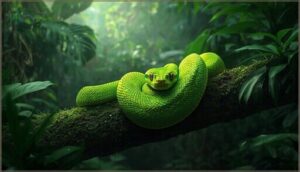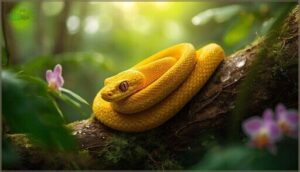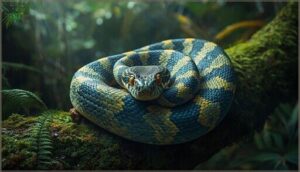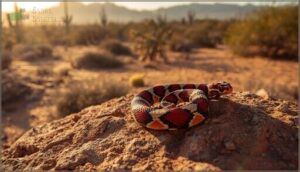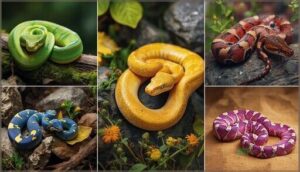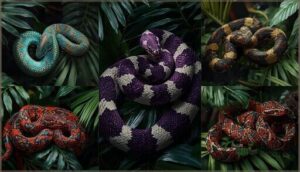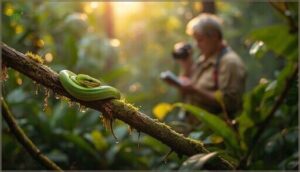This site is supported by our readers. We may earn a commission, at no cost to you, if you purchase through links.
Most people recoil at the sight of a snake, but these creatures display some of nature’s most stunning color palettes and patterns. From scales that shimmer with rainbow light to bodies adorned with electric blue stripes and geometric designs, the most beautiful snakes rival tropical butterflies and exotic birds in visual appeal.
Their beauty isn’t just skin-deep either—iridescence, color morphs, and intricate markings serve essential survival functions in the wild. Whether you’re drawn to the dangerous elegance of venomous species or the gentle allure of non-venomous varieties, you’ll find that snake beauty spans an exceptional spectrum of colors, textures, and forms that challenge everything you thought you knew about these misunderstood reptiles.
Table Of Contents
- Key Takeaways
- Defining Beauty in Snake Species
- Most Stunning Venomous Snakes
- Most Beautiful Non-Venomous Snakes
- Rare and Exotic Snake Color Variations
- Conservation and Safe Appreciation
- Frequently Asked Questions (FAQs)
- What are the world’s most beautiful snakes?
- What is the most venomous snake in the world?
- What snakes have iridescent scales?
- Are all beautiful snakes dangerous?
- Why are snakes so beautiful?
- What is the longest venomous snake?
- Is it safe to keep a pet snake?
- How can I tell if a snake is venomous?
- Are snakes endangered?
- How much space does a pet snake need?
- Conclusion
Key Takeaways
- Snake beauty extends beyond vivid colors to include iridescent scales that refract light through microscopic structures, creating angle-dependent rainbow effects that rival tropical butterflies and exotic birds.
- Venomous species like the Blue Malayan Coral Snake and Eyelash Viper prove that danger and stunning visual appeal coexist, with electric blue stripes and bright yellow morphs serving both survival functions and aesthetic intrigue.
- Non-venomous beauties such as the Brazilian Rainbow Boa and San Francisco Garter Snake offer safe appreciation opportunities, though many face serious conservation threats from habitat loss and illegal pet trade.
- Responsible observation requires maintaining safe distances of 6-10 feet, using telephoto lenses for photography, and understanding that only 15% of snake species are actually venomous despite widespread misconceptions linking beauty with danger.
Defining Beauty in Snake Species
When you look at a snake, what makes it beautiful? For some, it’s the striking patterns that seem painted across their scales. For others, beauty comes from the way light dances on iridescent skin or the unique features that set certain species apart.
Unique Coloration and Patterns
When you’re sizing up what makes a snake truly eye-catching, snake coloration and patterns are your starting point. Some species flash bright reds and yellows—color mimicry tricks that warn predators or fool them entirely. Others display geometric patterns or mottled scales for habitat camouflage.
What’s wild is that snake colors include UV reflectance invisible to us, and pattern complexity often determines whether observers see beauty or fear. Snakes use habitat matching techniques to blend seamlessly into their surroundings.
Iridescence and Sheen
Some snakes take coloration beyond pigment alone. Iridescent scales refract light through microscopic structures in their skin, producing angle-dependent rainbow effects—what researchers call structural coloration. Brazilian Rainbow Boas and Sunbeam Snakes showcase this brilliance when light hits at low angles.
Genetic variants in corn snakes can boost this sheen, creating composite appearances where iridescence overlays existing patterns for an unforgettable visual punch. Research shows that genes impact coloration in snakes.
Distinctive Physical Features
Beyond iridescent scales and vivid hues, physical form shapes how you perceive beautiful snakes. Studies show body shape matters—slender, smoothly contoured species consistently rank higher in beauty than stout ones.
Scale patterns and head shape draw your eye first. Pattern complexity itself drives ratings, with boldly banded snakes landing in the top beauty quartile. Color saturation amplifies appeal, but structure and form seal the impression.
Most Stunning Venomous Snakes
Not all dangerous snakes hide in dull camouflage. Some of the world’s most venomous species wear colors that stop you in your tracks—vivid blues, emerald greens, and intricate patterns that seem almost too stunning to be real.
Here are five venomous snakes that prove beauty and danger can go hand in hand.
Blue Malayan Coral Snake
You might think coral snakes are all the same, but the Blue Malaysian Coral Snake stands out with its electric blue stripes running along jet-black scales and bright red head.
This venomous snake from Southeast Asia packs a unique punch—its calliotoxin venom paralyzes prey through sodium channel blockage.
During diurnal activity periods in Singapore, you’ll spot these beauties hunting other snakes in tropical forests.
Emerald Green Pit Viper
With triangular heads and lime-green scales that blend into rainforest canopies, Trimeresurus macrops—the Emerald Green Pit Viper—mesmerizes observers across Thailand and Vietnam. You’ll recognize this beautiful snake by its unusually large eyes and pale side stripe. Its arboreal adaptation makes it a master of camouflage effectiveness in forest trees.
- Belongs to taxonomic classification family Viperidae, subfamily Crotalinae
- Accounts for up to 40% of venomous snakes bites in Thailand
- Venom potency causes coagulopathy and tissue damage
- Prefers elevated, closed-canopy forest with minimal human disturbance
- Lives in discrete home ranges smaller than one hectare
Eyelash Viper
From southern Mexico to northern Peru, the Eyelash Viper (Bothriechis schlegelii) displays some of the most striking color morphs among venomous snakes—bright yellow, pink, olive green, or speckled patterns that camouflage perfectly in arboreal habitats.
You’ll find these beautiful snakes hunting frogs, lizards, and birds in rainforest canopies, where venom toxicity ranges from 2–10 mg/kg. Though conservation status ranks as “Least Concern,” illegal wildlife trade threatens local populations.
| Characteristic | Details |
|---|---|
| Color Variation | Yellow, pink, olive, silver, gray morphs with speckles |
| Geographic Range | Mexico to Peru in humid tropical forests |
| Venom & Diet | Hemotoxic (LD50: 2–10 mg/kg); feeds on small vertebrates |
Rhinoceros Viper
In West and Central Africa, the Rhinoceros Viper (Bitis nasicornis) stands out among venomous snakes with geometric blue, green, and yellow camouflage patterns and distinctive snout horns—three to four elongated scales that give this beautiful snake species its name.
This ambush predator delivers venom with an LD50 of 1.1 mg/kg, yet habitat loss from deforestation threatens populations across its rainforest range.
Arizona Coral Snake
You’ll recognize the Arizona Coral Snake by its striking red, black, and white rings—a tricolor pattern that warns predators across Sonoran Desert habitats from sea level to 5,800 feet.
Though venomous with neurotoxic venom potency, this snake species shows fascinating defensive behaviors like tail-coiling and popping sounds rather than biting.
Its conservation status remains stable, and it anchors a complex mimicry complex with harmless kingsnakes throughout its range.
Most Beautiful Non-Venomous Snakes
Not all stunning snakes come with a venomous bite. Some of the most visually striking species are completely harmless to humans, making them favorites among reptile enthusiasts and pet owners.
Here are five non-venomous snakes that stand out for their striking beauty.
Brazilian Rainbow Boa
If you want beautiful snakes that shimmer like oil on water, the Brazilian Rainbow Boa delivers. Its iridescent scales refract light to create a natural rainbow effect across its brown-patterned body.
Found across Central South America’s humid forests, this medium-sized boa reaches 4–6 feet and lives up to 20 years in captive care. Females give birth to 2–35 live young after five months of reproduction.
Currently rated Least Concern for conservation.
Sunbeam Snake
You’ll find the Sunbeam Snake gliding through Southeast Asia’s humid forests with chocolate-brown to purplish-black scales that shimmer like a living prism. This fossorial beauty spends most of its time underground, hunting at night with impressive constriction power.
- Iridescent scales: Microscopic structures refract light into rainbow patterns across its smooth, polished body
- Nocturnal behavior: Emerges after dark and during heavy rains to hunt frogs, lizards, and small mammals
- Clutch size: Females lay 4–10 eggs, with hatchlings sporting a distinctive white collar that fades within their first year
Leucistic Texas Rat Snake
While the Sunbeam Snake catches light underground, the Leucistic Texas Rat Snake brings ghostly elegance to south-central U.S. forests with its ivory-white body and striking dark eyes.
You’re looking at a genetic marvel—reduced MITF gene expression strips away typical pigmentation, creating this stunning morph.
In captivity, these shy but sturdy colubrids live 10–20 years, thriving in 20–40 gallon setups with proper thermal gradients and becoming reliably handleable with patient interaction.
San Francisco Garter Snake
From white snakes to the California coast, you’ll encounter the San Francisco Garter Snake—a striking example of beautiful snakes now facing endangered status. This garter snake blazes with turquoise-blue underscales and burnt-orange racing stripes, yet habitat loss and prey decline threaten its survival.
Recovery efforts now focus on wetland restoration and genetic diversity monitoring to protect this rare California Red-Sided Garter Snake subspecies.
Red Tail Boa
Red Tail Boa populations stretch from Mexico to South America, making them one of the most recognizable beautiful snakes in the hobby. You’ll see striking color morphs in captivity—from classic brown saddles with red tails to designer patterns—yet wild habitat versatility defines their success.
These nonvenomous giants reach six to ten feet, displaying impressive size variation. Conservation status remains stable, though CITES monitors trade carefully.
Rare and Exotic Snake Color Variations
Some snakes look like they’ve been painted by nature’s most creative hand. These rare and exotic species show off color combinations you won’t find in your typical garden snake—think color-shifting scales, electric purples, and patterns that seem almost too bold to be real.
Let’s look at five snakes that prove Mother Nature has a wild imagination.
Paradise Flying Snake
You’ll spot the Paradise Flying Snake by its black body covered with green or yellow spots and eye-catching red diamond markings running down its back. This arboreal snake reaches about 1.3 meters and shows a solid greenish-yellow belly.
What makes this beautiful snake species unique? Its gliding mechanism lets it flatten and sail between trees, hunting lizards and frogs across Southeast Asia’s rainforests.
Aurora House Snake
The Aurora House Snake stands out with its olive green body and yellow-edged scales, plus an orange vertebral stripe running from head to tail. This beautiful snake species thrives in grasslands and savannas up to 1,700 meters.
- Averages 45-60 cm, reaching 90 cm maximum
- Features distinctive yellow scale edges
- Lives at habitat elevation up to 1,700 meters
- Lays egg clutches containing up to 12 eggs
Kalahari Purple-Glossed Snake
The Kalahari Purple-Glossed Snake captivates with its glossy scales that shimmer with a distinctive purple sheen, especially under bright light. This venomous species feeds on other snakes, and its striking appearance makes it one of southern Africa’s most sought-after sightings.
You’ll find this beautiful snake in arid habitats across eastern Namibia and northern Botswana, where its dark body rarely exceeds 48 cm.
Ringneck Snake
You’ll recognize the Ringneck Snake by its olive to smoky black body and distinctive neck band that varies from yellow to red-orange across regional populations.
This species shows considerable habitat diversity, spanning from Minnesota to Mexico in grasslands and forests.
While it carries mild venom in its saliva, you’re in no danger—it’s harmless to humans and generally measures under a foot long.
Scarlet Snake
You’ll find the Scarlet Snake’s coral snake mimicry fascinating—its black-bordered red blotches on light gray mimic venomous species, though it’s harmless. Adults average 36-51 cm, with snake patterns varying by region.
These secretive snakes inhabit underground burrows from the southeastern U.S. to Texas, feeding primarily on lizard eggs. Their conservation status remains stable, though captive care requires specialized knowledge of their burrowing behavior and diet requirements.
Conservation and Safe Appreciation
Appreciating these stunning snakes means understanding the delicate balance between admiration and protection. Many beautiful species face real threats from habitat loss and the illegal pet trade, so knowing how to observe them responsibly matters.
Whether you’re photographing wild snakes or keeping them as pets, following safe practices protects both you and these fascinating animals.
Threats to Beautiful Snake Species
Beautiful snakes face serious threats that put entire populations at risk. Habitat destruction from urbanization and deforestation has reduced some species’ ranges by 20% since 2000, while climate change could shrink habitats by up to 70% by 2070.
Beautiful snakes face extinction from habitat destruction, climate change, and illegal trade—threats that could eliminate 70% of their ranges by 2070
The illegal pet trade targets colorful species, and road mortality kills 10-15% of local populations annually. These endangered species need conservation action now.
Responsible Observation and Photography
Ethical photography starts with respecting snake habitats and keeping safe distances—at least 6 to 10 feet from wild snakes. Use a telephoto lens of 200mm or longer so you can capture stunning images without disturbing the animal or risking a strike.
Clean your gear between locations to prevent disease transmission, and avoid flash or sudden movements that provoke defensive responses in most encounters.
Safe Practices for Snake Enthusiasts
Safe handling practices extend beyond fieldwork into homes where captive snakes live. If you’re keeping snakes as pets, your enclosure must be at least as long as the snake’s full body length so it can stretch naturally. Handle your snake 5 to 10 minutes daily to reduce stress, and always wait 48 hours after feeding.
Snake enthusiasts should follow these core safety protocols:
- Wash your hands thoroughly after every interaction—81% of pet snakes carry Salmonella that transfers easily to humans
- Use feeding tongs to prevent your snake from associating your hands with prey during mealtimes
- Wear protective gear like leather gloves and snake-proof boots when working outdoors or with unfamiliar species
Training matters too. Venomous handling certification requires you to be 18 or older, and awareness courses stay valid for 2 years. Only 42% of students receive proper snakebite first aid training, so seek formal education before advancing to species that pose injury risks.
Frequently Asked Questions (FAQs)
What are the world’s most beautiful snakes?
You won’t believe how stunning some serpents can be. The world’s most gorgeous snakes showcase striking snake aesthetics through iridescent scales, exotic color mutations, vibrant patterns, and unique physical characteristics that reshape beauty standards.
What is the most venomous snake in the world?
The inland taipan holds the record, with venom potency metrics showing an LD50 of roughly 025 mg/kg in mice—far more potent than any other venomous snake species tested.
What snakes have iridescent scales?
You’ll find stunning scale iridescence in Brazilian Rainbow Boas, Sunbeam Snakes, and Aurora House Snakes.
Light refraction through microstructures creates a rainbow shimmer—like nature’s prisms dancing across their bodies in sunlight.
Are all beautiful snakes dangerous?
No. Only about 15% of snake species are venomous, and even fewer pose real danger to humans. Bright coloration doesn’t always signal venom—many stunning snakes use mimicry or aposematism as defense, not aggression.
Why are snakes so beautiful?
Think of a living prism: structural iridescence turns scales into light-bending art, while predator signaling demands bold color patterns.
Beautiful snakes marry camouflage aesthetics with sensory systems, creating nature’s most alluring color diversity.
What is the longest venomous snake?
The king cobra holds the title, regularly reaching 12–13 feet and occasionally hitting 18–19 feet. Black mambas come second at around 14 feet maximum.
Size factors include diet, habitat, and genetics affecting potent venom delivery.
Is it safe to keep a pet snake?
You’ll face zoonotic diseases like Salmonella (found in 65% of captive snakes), potential escape incidents, and legal restrictions depending on your state.
With proper handling safety and secure housing, snake pet safety is achievable.
How can I tell if a snake is venomous?
You can check for triangular heads and vertical pupils, but these features aren’t reliable across all species. Regional variations make visual identification tricky, so treat any unknown snake as potentially venomous and seek expert verification.
Are snakes endangered?
Yes, many snakes face extinction risk due to habitat loss, trade pressures, climate change, and disease threats. Snake conservation status varies, but forest-dwelling species and vipers are especially vulnerable.
Raising snake conservation awareness is essential for protecting snake habitats and environments.
How much space does a pet snake need?
Your pet snake needs an enclosure at least as long as its body length. Most snake owners should aim for length plus width equaling body length minimum, with species-specific needs and developmental stage affecting ideal dimensions.
Conclusion
Like living gemstones scattered across the planet, the most beautiful snakes remind us that nature’s artistry knows no bounds. You’ve seen how these creatures blend survival with striking design—from iridescent scales that catch sunlight to bold patterns that warn or camouflage.
Whether you admire them from afar or study them up close, these serpents prove that beauty exists in unexpected places. Your newfound appreciation might just change how you see the natural world around you.
- https://www.instagram.com/p/DHvbCveMfUb/?hl=en
- https://timesofindia.indiatimes.com/etimes/trending/top-10-colourful-snakes-in-the-world-from-rainbow-boa-to-corn-snakes/articleshow/117339842.cms
- https://florafaunafun.com/colorful-snakes/
- https://www.jagranjosh.com/general-knowledge/list-of-colorful-snakes-1820003077-1
- https://a-z-animals.com/animals/snake/snake-facts/most-colorful-snakes/



